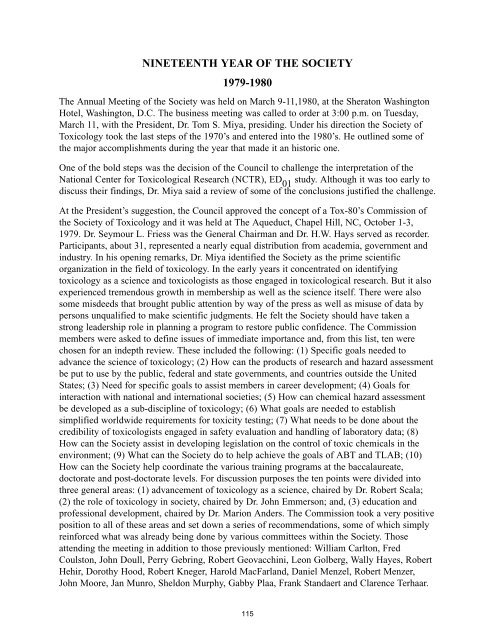SOCIETY O. TOXICOLOGY HISTORY - Society of Toxicology
SOCIETY O. TOXICOLOGY HISTORY - Society of Toxicology
SOCIETY O. TOXICOLOGY HISTORY - Society of Toxicology
Create successful ePaper yourself
Turn your PDF publications into a flip-book with our unique Google optimized e-Paper software.
NINETEENTH YEAR OF THE <strong>SOCIETY</strong><br />
1979-1980<br />
The Annual Meeting <strong>of</strong> the <strong>Society</strong> was held on March 9-11,1980, at the Sheraton Washington<br />
Hotel, Washington, D.C. The business meeting was called to order at 3:00 p.m. on Tuesday,<br />
March 11, with the President, Dr. Tom S. Miya, presiding. Under his direction the <strong>Society</strong> <strong>of</strong><br />
<strong>Toxicology</strong> took the last steps <strong>of</strong> the 1970’s and entered into the 1980’s. He outlined some <strong>of</strong><br />
the major accomplishments during the year that made it an historic one.<br />
One <strong>of</strong> the bold steps was the decision <strong>of</strong> the Council to challenge the interpretation <strong>of</strong> the<br />
National Center for Toxicological Research (NCTR), ED 01<br />
study. Although it was too early to<br />
discuss their findings, Dr. Miya said a review <strong>of</strong> some <strong>of</strong> the conclusions justified the challenge.<br />
At the President’s suggestion, the Council approved the concept <strong>of</strong> a Tox-80’s Commission <strong>of</strong><br />
the <strong>Society</strong> <strong>of</strong> <strong>Toxicology</strong> and it was held at The Aqueduct, Chapel Hill, NC, October 1-3,<br />
1979. Dr. Seymour L. Friess was the General Chairman and Dr. H.W. Hays served as recorder.<br />
Participants, about 31, represented a nearly equal distribution from academia, government and<br />
industry. In his opening remarks, Dr. Miya identified the <strong>Society</strong> as the prime scientific<br />
organization in the field <strong>of</strong> toxicology. In the early years it concentrated on identifying<br />
toxicology as a science and toxicologists as those engaged in toxicological research. But it also<br />
experienced tremendous growth in membership as well as the science itself. There were also<br />
some misdeeds that brought public attention by way <strong>of</strong> the press as well as misuse <strong>of</strong> data by<br />
persons unqualified to make scientific judgments. He felt the <strong>Society</strong> should have taken a<br />
strong leadership role in planning a program to restore public confidence. The Commission<br />
members were asked to define issues <strong>of</strong> immediate importance and, from this list, ten were<br />
chosen for an indepth review. These included the following: (1) Specific goals needed to<br />
advance the science <strong>of</strong> toxicology; (2) How can the products <strong>of</strong> research and hazard assessment<br />
be put to use by the public, federal and state governments, and countries outside the United<br />
States; (3) Need for specific goals to assist members in career development; (4) Goals for<br />
interaction with national and international societies; (5) How can chemical hazard assessment<br />
be developed as a sub-discipline <strong>of</strong> toxicology; (6) What goals are needed to establish<br />
simplified worldwide requirements for toxicity testing; (7) What needs to be done about the<br />
credibility <strong>of</strong> toxicologists engaged in safety evaluation and handling <strong>of</strong> laboratory data; (8)<br />
How can the <strong>Society</strong> assist in developing legislation on the control <strong>of</strong> toxic chemicals in the<br />
environment; (9) What can the <strong>Society</strong> do to help achieve the goals <strong>of</strong> ABT and TLAB; (10)<br />
How can the <strong>Society</strong> help coordinate the various training programs at the baccalaureate,<br />
doctorate and post-doctorate levels. For discussion purposes the ten points were divided into<br />
three general areas: (1) advancement <strong>of</strong> toxicology as a science, chaired by Dr. Robert Scala;<br />
(2) the role <strong>of</strong> toxicology in society, chaired by Dr. John Emmerson; and, (3) education and<br />
pr<strong>of</strong>essional development, chaired by Dr. Marion Anders. The Commission took a very positive<br />
position to all <strong>of</strong> these areas and set down a series <strong>of</strong> recommendations, some <strong>of</strong> which simply<br />
reinforced what was already being done by various committees within the <strong>Society</strong>. Those<br />
attending the meeting in addition to those previously mentioned: William Carlton, Fred<br />
Coulston, John Doull, Perry Gebring, Robert Geovacchini, Leon Golberg, Wally Hayes, Robert<br />
Hehir, Dorothy Hood, Robert Kneger, Harold MacFarland, Daniel Menzel, Robert Menzer,<br />
John Moore, Jan Munro, Sheldon Murphy, Gabby Plaa, Frank Standaert and Clarence Terhaar.<br />
115
















